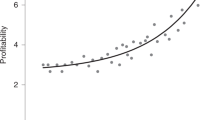Abstract
A model for sex allocation is presented where mothers have differing abilities to assess their arrival order at a patch in low-density populations. Mothers either oviposit with no knowledge, some knowledge, or they know their arrival order exactly. Furthermore they deposit single eggs in patches hence all matings within a patch are between unrelated individuals. The male offspring however, are also able to mate with females from male-less patches through dispersal. Whereas the first model predicted sex ratios of equality, the models incorporating knowledge both predicted female biased sex ratios. This is shown to be due to an asymmetry in mating opportunities that we have termed random asymmetrical mate competition (RAMC) that only knowledgeable females are able to use to their advantage. Data from the out-breeding non-pollinating fig wasp Otitesella pseudoserrata, suggests that these mothers do have knowledge of their arrival orders and supports the concept and predictions of RAMC.
Similar content being viewed by others
References
J Abe Y Kamimura H Ito H Matsuda M Shimada (2003) ArticleTitleLocal mate competition with lethal male combat: effects of competitive asymmetry and information availability on a sex ratio game J Evolut Biol 16 607–613 Occurrence Handle1:STN:280:DC%2BD3srlt1GmsQ%3D%3D Occurrence Handle10.1046/j.1420-9101.2003.00558.x
CI Bliss RA Fisher (1953) ArticleTitleFitting the negative binomial distribution to biological data Biometrics 9 176–200 Occurrence Handle10.2307/3001850
RA Fisher (1930) The genetical theory of natural selection Claredon Press Oxford
HCJ Godfray (1994) Parasitoids: behavioral and evolutionary ecology Princeton University Press New Jersey
Greeff JM, Fergusson WH (1999). Mating ecology of the non-pollinating fig wasps of Ficus ingens. Animal Behaviour 57: 215– 222.
WD Hamilton (1967) ArticleTitleExtraordinary sex ratios Science 156 477–488 Occurrence Handle6021675 Occurrence Handle1:STN:280:DyaF2s7ivFOltg%3D%3D Occurrence Handle10.1126/science.156.3774.477
ICW Hardy (Eds) (2002) Sex ratios: concepts and research methods Cambridge University Press England
J Maynard Smith (1982) Evolution and the theory of games Cambridge University Press England
GA Parker (1984) Evolutionary stable strategies JR Krebs NB Davies (Eds) Behavioural ecology: an evolutionary approach EditionNumber2 Blackwell Scientific Publications Oxford, UK 30–61
J Pienaar JM Greeff (2003a) ArticleTitleMaternal control of offspring sex and male morphology in the Otitesella fig wasps J Evolut Biol 16 244–253 Occurrence Handle1:STN:280:DC%2BD3srlsFyjsg%3D%3D Occurrence Handle10.1046/j.1420-9101.2003.00522.x
J Pienaar JM Greeff (2003b) ArticleTitleDifferent male morphs of Otitesella pseudoserrata have equal fitness but are not determined by different alleles Ecol Lett 6 286–289 Occurrence Handle10.1046/j.1461-0248.2003.00441.x
AF Read M Anwar D Shuker S Nee (1995) ArticleTitleSex allocation and population structure in malaria and related parasitic protozoa Proc Roy Soc Lond, Ser B 260 359–363 Occurrence Handle1:STN:280:DyaK2Mzlsleksw%3D%3D Occurrence Handle10.1098/rspb.1995.0105
J Seger (1983) ArticleTitlePartial bivoltism may cause alternating sex-ratio biases that favour eusociality Nature 301 59–62 Occurrence Handle10.1038/301059a0
DM Shuker SA West (2004) ArticleTitleInformation constraints and the precision of adaptation: sex ratio manipulation in wasps Proc Natl Acad Sci 101 IssueID28 10363–10367 Occurrence Handle15240888 Occurrence Handle1:CAS:528:DC%2BD2cXmtVyrsrc%3D Occurrence Handle10.1073/pnas.0308034101
DM Shuker I Pen AB Duncan SE Reece SA West (2005) ArticleTitleSex ratios under asymmetrical local mate competition: theory and a test with parasitoid wasps Am Natural 166 IssueID3 301–316 Occurrence Handle10.1086/432562
S Noort ParticleVan JY Rasplus (1997) ArticleTitleRevision of the Otitesella fig wasps (Hymenoptera, Chalcidoidea: agaonidae). 1: the Otitesella digitata species-group of the Afrotropical region, with a key to Afrotropical species of Otitesella Westwood Afr Entomol 5 IssueID1 125–147
SA West TG Smith AF Read (2000) ArticleTitleSex allocation and population structure in apicomplexan (protozoa) parasites Proc Roy Soc Lond, Ser B 267 247–263 Occurrence Handle10.1098/rspb.2000.0995
SA West SE Reece AF Read (2001) ArticleTitleEvolution of gametocyte sex ratios in malaria and related apicomplexan (protozoan) parasites Trends Parasitol 117 525–531 Occurrence Handle10.1016/S1471-4922(01)02058-X
JT Wiebes (1967) ArticleTitleRe-description of Sycophaginae from Ceylon and India, with designation of lectotypes, and a world catalogue of the Otitesellini (Hymenoptera, Chalcidoidae, Torymidae) Tydschrift Entomol 110 399–442
Author information
Authors and Affiliations
Corresponding author
Rights and permissions
About this article
Cite this article
Pienaar, J., Greeff, J.M. Adaptive non-Fisherian sex ratios in a patchily distributed population with outbreeding. Evol Ecol 20, 431–445 (2006). https://doi.org/10.1007/s10682-006-0012-1
Received:
Accepted:
Issue Date:
DOI: https://doi.org/10.1007/s10682-006-0012-1




